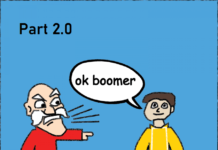“Devising an effective fear appeal is to some extent an art, but it is an art that requires a scientist’s appreciation of the intricacies of human behavior. (Perloff, Dynamics of Persuasion, p. 394)
It isn’t often that I stare at a blank screen, not knowing how to start an article. Many writers speak of something called writer’s block, where suddenly they have no idea what to say or express what they’re thinking. People who feel the urgent need to share information generally don’t have this problem. The difference between fiction and non-fiction writing can best be described, in my opinion, as the non-fiction writer is driven by a principle or an experience that drives his or her writing. It isn’t that fiction writers aren’t driven. Many of the best fiction novels are based on a reality that parallels the story being told. This certainly requires some research and an acute understanding of current events, or whatever the story is focusing on. My writing is driven by my experience in Social Work Education, where my class was forced to write a White Privilege position paper, and afterward, recite all the reasons we didn’t realize we were racist. I turned in a paper outlining why programs like affirmative action and quota-based admission programs were the real problem. I was later told that I wasn’t fit to be in the field, and as gatekeepers of the profession, the professor’s job was to keep people like me out. To me, the Marxist indoctrination throughout the program was obvious. I fought it tooth and nail. While I was able to finish the undergraduate degree, I was later denied the Master of Social Work degree after completing the program with a 3.5 GPA, for essentially the same reasons. While this is a story in and of itself that would take pages to tell, this marked the birth of my writing endeavors. For the past ten years, I have spent the larger portion of my free time studying Marxism/Communism and the psychology behind it. I use writing as a tool to learn and share what I discovered as our nation continues its leftward turn. While it isn’t often that I find myself without words, this morning an eerie quiet has settled over my mind as I struggle not with what to say, but how to say it. I have come to the belief that everything we witness in our nation, every story emanating from the media, all propaganda coming from the government, is based on a reality that is thoroughly understood about human behavior. Our reaction to fear and anxiety, and how to best use it as a tool to gain compliance, has been the subject of serious scientific inquiry for over one hundred years.
There is a dark reality that America needs to face, collectively. One that is almost, as a matter of general principle, automatically rejected when it is first heard because it contradicts everything we believe about the nature of being human. We believe we are free beings, created in God’s image, able to make our own decisions and lead our own lives based on the precept of free will. I believe in God; I believe we make our own choices, and that the concept of freedom requires we accept the consequences of our actions when our decisions are misguided. The frightening reality, however, (and I am not suggesting that God is not the reality) is that decades of scientific study have convinced others, through direct observation and rigorous experimentation, that human beings have animal-like traits, and our behaviors are not of our own will, but easily conditioned through high levels of stress and fear. This is the reality that governs us today. Our government is not made of people who espouse personal responsibility, individual liberty, and deeply rooted religious values upon which we believe our nation was founded. These principles have been rejected for a scientific approach of governing, often referred to as a technocracy, which views people as just another animal, with no special characteristics which separate us from them. B.F. Skinner, a pioneer of human behavior, who took Pavlov’s conclusions on conditioning to the next level, stated in Science and Human Behavior (p. 38) that when it comes to the study of behavior, it would be rash to assume there is a fundamental difference between the way animals and humans behave. Skinner also states (p.5) that there is no point in developing a science of nature unless it focuses exclusively on the nature of human beings because understanding human behavior will inevitably lead to more effective methods of control. A working model of studying behavior, according to Skinner (p.6), demands that we accept whatever conclusions the application of science leads us to. Skinner’s conclusion, based on his own experimentation with Pavlov’s concept on conditioning, is that our behavior is largely shaped by our environment, and any control over it equals control over behavior.
“In what we may call the pre-scientific view (and the word is not necessarily pejorative) a person’s behavior is at least to some extent his own achievement. He is free to deliberate, decide, and act, possibly in original ways, and he is to be given credit for his successes and blamed for his failures. In the scientific view (and the word is not necessarily honorific) a person’s behavior is determined by a genetic endowment traceable to the evolutionary history of the species and by the environmental circumstances to which as an individual he has been exposed. Neither view can be proved, but it is in the nature of scientific inquiry that the evidence should shift in favor of the second.” (Skinner, Beyond Freedom and Dignity, p. 101)
Skinner is saying that any serious inquiry into human behavior should be taken from what he refers to as, the scientific view. This is the perspective that humans are not in control of their behavior and that we are easily programmable. According to the book Battle for the Mind, by William Sargent, (xxviii), which was published in 1957, most of the medical world has been indoctrinated into Pavlovian thinking. This means that the medical sciences that we turn ourselves over to, for the past several decades, have viewed behavior and our physiology, as being no different than an animal. The idea of men having a soul, and a will of our own, is non-existent. This isn’t to say that individual doctors may not hold a religious worldview, but that the medical practice follows what science dictates. According to Sargent, Pavlov’s experiments led him to the conclusion that there was no fundamental difference in the way the brain and nervous systems function between dogs and humans. In fact, Pavlov found that the dog’s reactions to high levels of stress, and how their behavior could be changed because of a severe psychological breakdown, were not different than what was being discovered in terms of war-induced neurosis in human beings (xxii). What was discovered is that both animals and humans, after exposure to extreme stress, anxiety, or fear, can be brought to the point of emotional collapse, after which behavior could be easily altered, or there was a complete loss of the nervous symptoms (pertaining to people) which created the condition in the first place (xxv), making the subject more susceptible to behavior changes.
I am not a scientist. While having gone through the Master of Social Work program, I do have a basic understanding of conditioning, Pavlov, Skinner, and other psychological theories. I am a writer driven by an urgency to share with readers what my personal research has led me to believe. Over the years, I have learned to cite more than one relevant source in trying to prove my conclusions or speculative opinions. My experience in Social Work education is important because it was here that I learned about Saul Alinsky and his book Rules for Radicals. What does the book Rules for Radicals have to do with Pavlovian or Skinnerian Conditioning? Considering that the study of fear and the effects of acute trauma on the human psyche has been going on for several decades, there is a very relevant quote in the book which aligns with what others have to say on the subject. This quote pertains directly to what was already known about human behavior decades before the book was written. If you break people down to the point of complete exhaustion, they can be brought to accept anything.
“Any revolutionary change must be preceded by a passive, affirmative, non-challenging attitude toward change among the mass of our people. They must feel so frustrated, so defeated, so lost, so futureless in the prevailing system that they are willing to let go of the past and chance the future. This acceptance is the reformation essential to any revolution.” (Alinsky, Rules for Radicals, xx)
This is a quote that I have been using for several years. The story of how I came to understand Alinsky goes back to the undergraduate Social Work program. When I found out our textbooks were essentially referring to him as a hero, I bought the book and brought it to class. Every time he came up, I would read a quote from the book, out loud. In my view, everything we see in terms of propaganda, even things that seemingly go the way would want it to go, is an application of this principle. If you know anything about Marxism then you are familiar with the Hegelian Dialectic, or the problem-reaction-solution principle. The government deliberately creates a problem, which causes panic and stress, and waits for us to demand the predetermined solution. What if, after decades of study, they have learned to persuade us into accepting their solutions? Solutions absent the stress, we would never accept. Unfortunately, this seems to be the case. On page 16 of Battle for the Mind, you will find the following passage.
“Application of these findings about dogs to the mechanics of many types of religious and political conversions in human beings suggests that for conversion to be effective, the subject may first have to have his emotions worked upon until he reaches an abnormal condition of anger, fear or exaltation. If the condition is intensified or maintained by one means or another, hysteria may supervene, whereupon the subject can become more open to suggestions which under normal circumstances, would be summarily rejected.” (Sargent, Battle for the Mind, p. 16)
How is this different from the Alinsky quote? It isn’t, and it states in a very direct manner that they know they can get you to accept things you normally wouldn’t if you are frightened enough. What they have come to discover, however, is that it isn’t the fear itself that induces compliance. It is the removal, as Pavlov noted, of the nervous symptoms after complete exhaustion, which makes one more susceptible to suggestions. After decades of study and refinement of the technique, it has become something taught as a matter of simple principle in any marketing, or persuasive communications class. In the book Dynamics of Persuasion: Communications and Attitudes in the 21st Century, Richard Perloff discusses the technique known as Fear-then-Relief.
“This is somewhat different from other techniques in that the persuader deliberately places the recipient in a state of fear. Suddenly and abruptly, the persuader eliminates the threat, replaces fear with kind words, and asks the recipient to comply with a request. The ensuing relief pushes the persuade to acquiesce.” (Perloff, Dynamics of Persuasion, p. 464)
According to Perloff, (p. 464) this technique is effective because the relief experienced when the fear stimulus is removed is reinforcing and associated with the following request for compliance. In other words, a clever individual working through the subtleties of human behavior can frame a request for compliance in a way that aligns with the relief felt when the fear stimulus was removed. It is believed, and this goes all the way back to Pavlov, that people experience a state of mindlessness in this state of relief and that their willingness to go along with any suggestion afterward, is automatic as they associate the relief with the suggestion. It is my opinion, albeit not a popular one, that this technique was at work in the 2016 presidential elections and during the Trump presidency. This opinion isn’t formed by a dislike of Trump, I voted for him both times, but by the information provided in this article, and the countless hours I have spent studying this topic. Very few people put up any resistance to Trump’s bump stock ban and support for red flag laws. You could provide absolute proof that his DOJ was providing taxpayer-funded bribes to states to pass these laws and it would virtually be ignored. It is my opinion that this is because people were so relieved, and rightfully so, that Hillary didn’t win, they were willing to accept whichever direction Trump was going to go. I only brought that into this discussion to show how my opinions were formed on the subject. Eight years of Obama’s rampant liberalism certainly brought America to a point of desperation. The question is, did the powers that be apply their understanding of our response to stress to the election? I would argue that they apply the technique in all aspects of society. Especially presidential politics, if for no other purpose but to keep us going to the polls under the misguided belief that our vote matters for anything and that we have freedom of choice.
I can’t prove beyond any reasonable doubt that this information is being applied in any way. All I can do is show the beliefs of the scientists who espouse it, and how it may relate to what we are experiencing in society. It is difficult to reject the idea, however, that we are being propagandized. People on the right constantly refer to the existence of the deep state. What would the deep state be except an entity that applies what is known about human psychology and stimulus-response mechanisms to governing? No one could argue that the media is presenting us with an unbiased representation of current events and that the stories aren’t presented in a sensational way meant to show that we are always on the verge of absolute chaos. Is it possible that the technique of Fear-then-Relief and the knowledge of our reactions to stress and trauma has been so refined that they can apply it in such a subtle manner that the public remains blissfully unaware? I don’t know, but when you consider the information and quotes provided in this article, it sure seems like a distinct possibility. Here is one more pertaining to Skinner and the manipulation of the environment, for good measure.
“To the extent that relevant conditions can be altered, or otherwise controlled, the future can be controlled.” (Skinner, Science and Human Behavior, p. 6)
I find that terrifying.
To learn more about Fear-then-Relief and other fear-based behavioral models, check out my book,
Without a Shot Indeed: Inducing Compliance to Tyranny Through Conditioning and Persuasion.

























